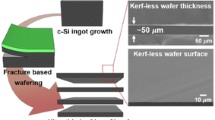Abstract
Breakage of GaAs wafers during device fabrication leads to reduced yield and decreased quality control. Historically, wafer breakage that is not attributable to human or equipment errors has been assumed to be due to poor quality wafers. We present evidence that the probability of breakage during sub-micron GaAs device fabrication is a function of dielectric film edge stress, and not necessarily dependent on the magnitude of a critical flaw in the as-received wafer. X-ray residual stress measurements, x-ray topographic imaging, and three-point bend fracture measurements are used to determine the nature and origin of wafer breakage during those fabrication steps which induce large mechanical or thermal stresses. Our data show that the processing sequences that most influence wafer breakage are SiN passivation deposition and rapid thermal annealing implant activation. These processes are primarily responsible for large residual stresses developed in the near-surface layers of the GaAs substrate. For microelectronic applications, the existence of high film edge stresses nucleates microcracks, which further reduces fracture strength. The combined effects of high residual stress and low fracture strength make SiN passivated wafers more fragile (as compared to SiON passivated wafers), and therefore more likely to break during device processing.
Similar content being viewed by others
References
A. Ward and R.W. Hendricks, Advances in X-ray Analysis, 39, 1995, p. 289.
K.J. Ely, Ph.D. Dissertation, Virginia Polytechnic Institute and State University, Blacksburg, VA, June 1993.
B.E. Warren, X-ray Diffraction, (New York: Dover Publications, 1990), p. 315.
A Ward, Ph.D. Dissertation, Virginia Polytechnic Institute and State University, Blacksburg, VA 24061, June 1996. (This document can be viewed on the Internet at http://scholar.lib.vt.edu/theses/public/etd-394172159651721/etd-title.html.)
P.B. Hirsch, Dislocations and Properties of Real Materials, (London: The Institute of Metals, 1985), p. 333.
S.B. Batdorf, Fracture Mechanics of Ceramics, 3rd Ed., ed. D. Hasselman, (New York: Pergamon Press, 1978).
C.J. Morrissey, NASA Tech Brief, v. 11, No. 1, Item 13, Jet Propulsion Laboratory, CIT, Pasadena, CA, February, 1987.
W. Weibull, J. Appl. Mech. 18, 293 (1951).
Author information
Authors and Affiliations
Rights and permissions
About this article
Cite this article
Ward, A., Hendricks, R.W. Process-induced stress and microcrack nucleation in GaAs wafers. J. Electron. Mater. 27, 821–825 (1998). https://doi.org/10.1007/s11664-998-0102-7
Received:
Accepted:
Issue Date:
DOI: https://doi.org/10.1007/s11664-998-0102-7



